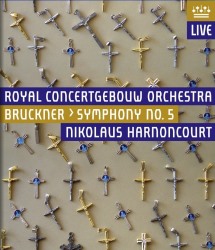|

|
Anton BRUCKNER (1824-1896)
Symphony No. 5 in B flat major (1875-76) (Nowak 1951, 3rd rev. ed. 2005) [67:43]
Royal Concertgebouw Orchestra/Nikolaus Harnoncourt
rec. live, Concertgebouw Amsterdam, 25 and 27 October 2013
RCO LIVE RCO14106 Blu-ray [74:18]
Judging by the number of recordings it has received Bruckner’s mighty Symphony No. 5 has gained in popularity sufficient to take its place alongside the Fourth, Seventh, Eighth and uncompleted Ninth. Along with the melodic Seventh, it is my favourite among his nine-plus works in the genre.
Nikolaus Harnoncourt made a well regarded, if somewhat controversial, super audio recording with the Vienna Philharmonic almost ten years ago for RCA. It received a Gramophone award nomination. The recording included a separate rehearsal CD that unfortunately did not have translations of the conductor’s German comments. His interpretation of this mammoth work has changed little over the past decade. The big advantage of this blu-ray is having the opportunity to watch Harnoncourt conduct and the superb orchestra perform. There's also excellent camera work essential for complete enjoyment. Whenever there is a solo the camera focuses on it. The prevailing red-brown color of the lighting adds to the warmth of the hall’s wonderful acoustics. This contrasts with Harnoncourt’s rather austere way with the music. His approach is indeed monumental, but more architectural than spiritual. In its way it is a convincing view of the symphony. However, there are other interpretations that emphasize the spiritual elements to a greater degree. As before, Harnoncourt’s tempos are on the quick side, especially the second movement marked Adagio. Sehr langsam. One would describe this movement as more of an andante, which the conductor takes in two rather than four beats to the measure. In this performance the movement lasts 12:30 while on the audio recording it took 14:57, although the new one does not seem that much faster than before. Contrast this with such others as Karajan, Sawallisch or Thielemann, all of whom require some twenty minutes here. Another great interpreter, GŁnter Wand, also takes the second movement more quickly, the timing coming in near that of Harnoncourt’s earlier account. I feel that both tempos can work and I actually prefer the more flowing one. The rather sorrowful oboe solo that begins this movement is beautifully played here, as it was in the recording with the Vienna Philharmonic.
In each of the other movements Harnoncourt is marginally faster than before, by some two minutes in the big finale (23:59 vs. 21:54). He handles this vast edifice well in both accounts. I especially liked the Concertgebouw woodwinds and found that the clarinetist captured the humour at the start of this movement better than his Vienna Philharmonic counterpart. This was apparent from the video but also when I listened to the blu-ray on my stereo system. Otherwise, there is little to choose between the two orchestras and the respective sound from two acoustically flattering venues, the Concertebouw and Vienna’s Musikverein. The main question remains whether or not you are a fan of Harnoncourt in this music. His dynamic range is extreme so that the plucked ostinato motif in the lower strings beginning the work is basically inaudible unless you turn up the volume only to have the climaxes in the brass blast out at you. Undoubtedly this was the conductor’s intention. His emphatic way with the first theme in the third movement Scherzo may not be to all tastes, but the Viennese lilt he gives the second theme is delightful and so is his simple treatment of the trio. He steers a steady course through the finale with its reminiscences of previous movements and its double fugue. The brass chorales are really splendid and he concludes the symphony in a blaze of glory. The last note is barely finished when a loud “bravo!” erupts from a member of the audience. One thing that has always bugged me as the symphony nears its grandiose ending is the wonderful horn part, which is usually buried under the rest of the orchestra. I want it to be more present. On neither this recording nor the earlier SACD — or on others I have heard — does it ring out the way I think it should. I listened to Wand’s account with the Munich Philharmonic (Profil) on Spotify and there finally you can really hear those horns.
The blu-ray, as I suspect is typical of RCO Live issues, does not contain any extra material. The notes in the booklet are adequate but do not equal the detailed ones accompanying the RCA audio disc. To conclude, if you appreciate Harnoncourt’s way with this music — and it is a valid approach — then this blu-ray is recommended for the visual as well as the audio aspects. If you already have his earlier audio-only version, there is not enough difference in interpretation or performance to justify adding this new one to your collection unless you are interested in seeing Harnoncourt conduct the work.
Leslie Wright
 |
 |
|
